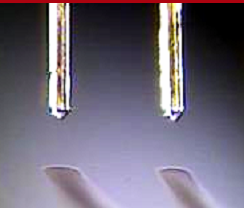Principle. A voltage of 1 - 2 kV is applied to a liquid while a substrate is grounded. Micrometer-scale spots or lines of liquid/solutes are deposited by reducing the spray-distance to 1.5 - 0.2 mm at a liquid feed of nL - pL/s. The charged droplets are attracted to the substrate and form a homogeneous layer of solutes.
Dotting in wells (silicon nitride surface). Reproducible dotting is achieved into etched wells of 400 micron in width and 50 micron deep. Flow rate is 0.2 nL/s and the spraying distance is 400 micron. In-between dotting the spraying is forced to stop by rapidly increasing the distance to the substrate from 350 micron to 450 micron.
Parallel spraying of homogeneous lines. A glass slide is moved underneath 8 fused silica capillaries at a speed of 2 mm/s allowing to dispense 8 lines of different liquids. The line-width is approximately 50 micron at a flow rate of 0.3 nL/s and a spraying distance of 300 micron. The capillaries are 150 micron in outer diameter and spaced 0.6 mm apart. Each capillary collects liquid from a separate well of a microtiter plate. This system can be scaled-up to 24 or 48 capillaries.
Spraying of lines onto Pd-coated glass-slide. The line width is 0.18 mm at a flow rate of 0.3 nL/s and a spraying distance of 400 micron. The initial speed of the glass-slide is 0.23 mm/s followed by a speed of 2 mm/s.
Liquid feed from titer plate wells
Silica capillary
Liquid cone
Spray of nm-sized droplets (invisible)
Deposited layer
400 micron











